LEV TAHOR TIMELINE
1962: Shlomo Helbrans was born in Israel.
1988: Lev Tahor was founded in Israel.
2000: Shlomo Helbrans was released from prison and deported to Israel.
2000: Lev Tahor’s centre moved to Canada.
Early 2000s: Lev Tahor expanded to the United States, Canada and Britain.
2014: Lev Tahor left Canada, with some its members settling in Guatemala, El Salvador and Mexico.
2017 (June): Helbrans reportedly drowned in a river in Mexico.
FOUNDER/GROUP HISTORY
Lev Tahor is a Hasidic group. Its name, meaning “pure heart,” stems from Psalms (51, 12): “Create in me a pure heart, O God; and renew a steadfast spirit within me.” In its own publications, the group prefers a semi-Ashkenazi rendering of its name, Lev Tohor. (Unless otherwise indicated, this article transliterates Hebrew words according to the Modern Hebrew pronunciation.)
The founder of Lev Tahor, Shlomo Helbrans, (1962-2017) was descended from the old Sephardic family Albaranes. He was raised in an irreligious environment in a low-income neighbourhood of West Jerusalem. While attending a state secular high school, he received a research task to investigate the life of ultra-Orthodox Jews in a religious neighbourhood. He approached one of the most important communities, the Satmar Hasidim. This largest Hasidic group in the world offered Helbrans warm welcome and invited him to learn more about Judaism. It was within that group that he acquired solid grounding in Jewish religious sources.
Having embraced Haredi Judaism, Helbrans showed a talent in attracting secular Jews to it. He 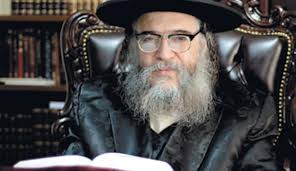 became a rabbi and a Torah educator, and in 1988 was employed by Arakhim, an adult education institution teaching Judaism mostly to irreligious Israelis. Successful in Judaic outreach, he started his own yeshiva and, eventually, his own Hasidic group thus becoming the Rebbe of Lev Tahor. [Image at right]
became a rabbi and a Torah educator, and in 1988 was employed by Arakhim, an adult education institution teaching Judaism mostly to irreligious Israelis. Successful in Judaic outreach, he started his own yeshiva and, eventually, his own Hasidic group thus becoming the Rebbe of Lev Tahor. [Image at right]
It was also from his exposure to Satmar that he acquired strong anti-Zionist views. He was influenced by the fundamental Judaic anti-Zionist treatise, Vayoel Moshe, authored by Rabbi Yoel Teitelbaum (1887-1979). (Cohen 2019)Teitelbaum was the spiritual leader of the Satmar Hasidim and one of the most prominent inspirational figures in Neturei Karta, which originally was a non-Hasidic Haredi group (Haredi refers to those Jews often described as Ultra-Orthodox in Western sources) that was established in 1938 and was actively opposed to Zionism).
Helbrans’ uncompromising approach to Judaic observance and faith, as well as his effective anti-Zionist propaganda brought upon him denunciations and violence, which also affected his family. In 1991, accused of maintaining contacts with Hamas and fearing the fallout of the Gulf War, he moved his yeshiva and his fledgling community to Brooklyn, New York. He continued his work there, attracting a number of Israelis who traveled to the United States to join Lev Tahor. One of his students was underage, which resulted in Helbrans being convicted of kidnapping a minor. The trial was widely covered in Israeli press, and an employee of the Israeli consulate attended the hearings, publicly denouncing the defendant. The Rebbe served a prison sentence and was deported to Israel in 2000. It remains unclear whether the accusation was founded since the boy claimed at the trial that he had run away from his abusive family. Several years later the former student, already an adult and visibly not a member of Lev Tahor, attended the wedding of one of Helbrans’ children, which puts the accusation in further doubt.
Continuing his outreach activities in Israel, Helbrans and his family found themselves surrounded by hostility from some other Hasidic groups and from Zionist militants. He received death threats, his house was stoned, head covering was repeatedly torn from his wife (A Haredi woman covers her hair and tearing the head covering from her is tantamount to insult and humiliation), and his seven-year-old son was tied to a tree and left there for several hours. After two years in Israel, Helbrans fled to Canada and sought protection there. The Immigration and Refugee Board of Canada declared the rabbi a refugee from Israel. In an unprecedented move, Canada’s Minister of Justice, a position occupied at the time by the well-known Zionist activist Irwin Cotler, appealed the decision, but failed to overturn it. This gave Helbrans the opportunity to rebuild 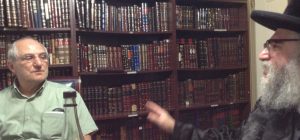 and expand his community in Sainte-Agathe-des-Monts, Quebec, a small town about a hundred kilometers northwest of Montreal. [Image at right]
and expand his community in Sainte-Agathe-des-Monts, Quebec, a small town about a hundred kilometers northwest of Montreal. [Image at right]
While living in Canada, Helbrans published a compendium of Judaic arguments against heresies, focusing on Zionism and the new Israeli secular identity, titled Derekh Hatsalah, Path of Rescue (Helbrans 2001), as well as a number of brochures in English, Hebrew, Arabic and Persian. He took part in anti-Zionist and pro-Palestinian rallies and gave interviews to Canadian and international media, proposing to establish a “World Anti-Zionist Congress.”
As he continued to attract Israelis to Lev Tahor, Helbrans, albeit residing in Canada, became the object of public attacks in Israel, first in the media, and later in the Israeli parliament. Eventually, this pressure from Israel resulted in Helbrans being accused by Quebec authorities of child abuse and running illegal schools. In search of greater freedom of religious education and fearing an imminent removal of children from their homes, he moved a part of the community to the neighbouring province of Ontario. After a short lull, Ontario authorities followed suit of their Quebec counterparts, which forced Helbrans to flee with several families of followers to Latin America.
Reportedly, he drowned in a river in June 2017 in the Mexican state of Chiapas while doing ritual immersions on the eve of the Sabbath. The circumstances of Helbrans’ death remain murky. It was reported that the Israeli embassy attempted to take the body but was prevented from doing so. There was no autopsy performed. (“More on” 2017)
DOCTRINES/BELIEFS
Lev Tahor shares basic Judaic principles with other Orthodox denominations of Judaism. Since Lev Tahor was founded only at the end of the twentieth century, it could not rely on transmitted tradition but rather had to create a tradition on the basis of a variety of Hasidic and, more generally, Kabbalistic sources. Besides Satmar, two other Hasidic movements, pre-World War II Chabad and Toldoth Aharon, provided inspiration for the doctrinal foundations and behavioural framework of Lev Tahor. A particular emphasis is put on preserving purity of thought and faith, concentration during prayer, and maintaining a high degree of intentionality throughout the day. The role of the human mind is exalted as a ruler of the heart and essential for developing love and fear of God. Detailed study of Hasidic and other mystical texts, including the Rebbe’s writings, constitutes the daily routine of Lev Tahor members. As in other Haredi communities, in-depth studies and mystical meditational practices are reserved for men only. Contrary to mainstream Satmar and more in accord with Chabad and Toldoth Aharon, male members of Lev Tahor, including young unmarried boys, are encouraged to study esoteric literature under proper guidance.
Principled opposition to Zionism is another important doctrinal feature of Lev Tahor. It is grounded in the biblical postulate of divine justice: God punishes Jews for their transgressions and all calamities befalling them are meant to bring them to repent. This postulate leads to the definition of the Exile as an experience enabling repentance. Lev Tahor follows in the footsteps of classical Judaic sources, including explicit verses in the Pentateuch (Leviticus 26:27-33), affirming that the Exile is a collective punishment for transgressions committed by the Jews. Consequently, Talmudic sources attribute the loss of the Jerusalem Temple in the first century CE to misbehaviour on the part of the Jews. The only acceptable way to terminate the Exile would be to repent and to wait for the Messiah. The Messiah alone would be authorized to terminate the Exile in the context of liberation of the entire humanity from suffering. The Exile has therefore acquired theological and spiritual meaning over and above a simply military defeat by Roman legions.
The Exile is also viewed as having a positive aspect, a providential opportunity to bring holiness to the entire world by fulfilling the Judaic precepts. According to this doctrine, shared by Lev Tahor with many other ultra-Orthodox Jewish groups, the establishment of the Zionist state of Israel is considered a profanation of Judaism and a challenge to divine providence (Rabkin 2006). In addition, according to Derekh Hatsalah, the future messianic redemption is expected to have an apocalyptic nature. The physical Jerusalem is to be destroyed and replaced by a heavenly city, while the entire world might be transformed into a mystical holy land. Conversely, the other main anti-Zionist groups, Neturei Karta and Satmar, do not have definitive views on this issue.
Judaic anti-Zionist thought is usually based on the teaching of the Three Oaths. The Babylonian Talmud (Kethuboth, 111a) relates that, at the time of dispersion after the destruction of the Jerusalem Temple, God imposed three oaths: not to return en masse and in an organized fashion to the Land of Israel; not to rebel against the nations; and that the nations do not subjugate Israel exceedingly. Moreover, it is forbidden for the Jews to hasten the messianic redemption by force. The Talmud allows individuals to settle in the Holy Land, but there is a consensus against massive immigration. Rabbis invoke the Three Oaths as binding prohibitions, an integral part of the Judaic law, throughout the centuries (Ravitzky 1996:211–34). They assert that even if all the nations were to encourage the Jews to settle in the Land of Israel, it would still be necessary to abstain from doing so, for fear of violating these oaths. Moreover, committing yet other sins due to the stricter status of the Holy Land in Judaic law might lead to an even more cruel exile.
Kabbalah and Hasidism view exile as a broken and corrupt state of the entire universe overrun by forces of evil until the cosmic repair, which is expected to happen with the supernatural advent of the Messiah. Any attempt to exit the exile by human means would, according to this view, pointless by definition.
This religious outlook stands at the heart of Lev Tahor’s rejection of Zionism and of the Zionist state. Unlike some Haredim who softened their opposition and came to collaborate with Israeli authorities (all the while affirming their ideological rejection of Zionism), Lev Tahor, in accordance with the teachings of Rabbi Yoel Teitelbaum of Satmar, elevates anti-Zionism to a cardinal principle of faith. Any agreement or cooperation with the Zionists, even as lip service, is considered a form of apostacy and heresy.
Lev Tahor rejects the Zionists’ claim that the state of Israel represents the Jews of the world and emphasizes the basic incompatibility of Judaism and Zionism, considering the latter to be “the real enemy of the Jews” (Hisachdus 2002:12). Such an attitude is not unique to Lev Tahor or even to Jews (Hart 2015), but this Hasidic community puts particular emphasis on combatting Zionism. In 2000-2011, Lev Tahor maintained contacts with Arab countries and welcomed political and media personalities in its compound in Sainte-Agathe. Lev Tahor reiterates its commitment to live in peace with the Palestinians under their government and, just as many other Haredi groups, believe that assuming political power before the arrival of the Messiah (which, of course, is not viewed as an earthly political event) is a dangerous and self-destructive heresy. Emphasizing purity of faith, Lev Tahor holds that the slightest deviation from the Kabbalah-based Judaic theology would bar the heretic from the World to Come, the usual Judaic reference to the Paradise.
Attempting to imitate the life in Hasidic shtetls of Eastern Europe, Lev Tahor Hasidim learn Yiddish in order to avoid everyday use of Hebrew, traditionally called “the language of holiness”. They no longer teach their children Modern Hebrew, which is the mother tongue for most of of them.
Artificial though it may be, their determination can be seen as a reaction to the no less artificial (and successful) efforts undertaken by Eliezer Ben Yehuda, born Leizer Perlman (1858-1922) when he abandoned his mother tongue, Yiddish, for the Hebrew that he “desanctified” and transformed into a vernacular. The Hasidim of Lev Tahor believe they are restoring the erstwhile sanctity of Hebrew by 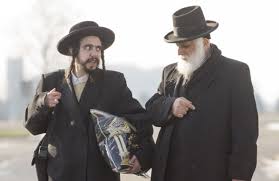 using it exclusively for prayer and Torah study, but insist on speaking Yiddish among themselves, or, at least, before they master Yiddish, the language of their respective non-Jewish milieu. [Image at right]
using it exclusively for prayer and Torah study, but insist on speaking Yiddish among themselves, or, at least, before they master Yiddish, the language of their respective non-Jewish milieu. [Image at right]
Lev Tahor publications affirm that
Zionism is leading the Jewish people and all the inhabitants of the holy Land of Israel towards catastrophe. … Zionism is complete heresy and has no basis in Judaism whatsoever. … The Zionist state will ultimately be annulled, and from all their activities in the Holy Land only terrible destruction and desolation will remain (Hisachdus 2002:4).
They maintain that the State of Israel is a danger not only for the Israeli Jews, but all the Jews around the world. Furthermore, based on traditional Judaic interpretations of Biblical prophecies and sacred oral traditions, Helbrans claims that today’s Jerusalem is destined to become desolate as the future epicenter of apocalyptic wars.
Furthermore, according to Lev Tahor, Israel has now become too dangerous a place to live, in both physical and spiritual sense since even Jews committed to fight Zionism would find it almost impossible to maintain a truly Jewish lifestyle in the Holy Land. Thus, Lev Tahor actively encourages Israeli Jews to repent for their past commitment to Zionism and to emigrate to other countries, especially Muslim ones, which he deems more fitting for the Orthodox Jewish lifestyle. The author blames the Zionist ideology for triggering the Holocaust and warns that Zionist activities may lead to another catastrophe even for the most sincerely God-fearing Jews.
Lev Tahor’s doctrine proposes a peaceful dismantlement of the Zionist state rather than its transformation into a theocracy. Since the Jewish state is a heresy in itself a theocratic version of it would be, according to Lev Tahor, even worse, a fully institutionalized and misleading heresy. On the practical level, these Haredi Jews accept the idea of a secular, democratic state, which was the original demand of the PLO and is acquiring growing popularity among the Palestinians. Lev Tahor maintains the traditional approach that enjoins the Jews to live under the rule of other nations and wait for the arrival of the Messiah.
Unlike Teitelbaum’s Vayoel Moshe, a sophisticated scholarly anti-Zionist classic addressed to rabbis and advanced rabbinical students, Helbrans’ Derekh Hatsalah is written in a simple accessible style. Originally published as a thin booklet, Derekh Hatsalah’s newer editions gradually grew into a large tome (Helbrans 2001). A large part of the book is dedicated to purity of faith, prayer and repentance. The author calls the faithful to stay away as far as possible from all evil and impure influences and associations, especially the religious Zionists, who he considers arch-heretics only pretending to be Jews as a diabolic deception. These are followers of National Judaism (dati-leumi), who are committed Zionists and who, unlike the Haredim, are largely integrated in the mainstream Israeli society. He also calls the Jews to engage in public anti-Zionist meetings and protests.
In 2007, the community started publishing a series of brochures on practical meditation for internal use. In 2011, Helbrans used their content to publish his magnum opus, Ohr Hashem, God’s Light (Helbrans 2011), a large practical guide to mystical meditation. The main part of Ohr Hashem comprises about 500 pages, supplemented by the author’s own comments and followed by a detailed index. Intended to be the first of a multi-volume set, the book combines Kabbalistic dogmatic theology and philosophical insights with practical meditation techniques. The author maintains that every sincere seeker of spirituality, regardless of gender or being Jewish, is, after proper training and ascetic practice, capable of experiencing mystical union with God.
Curiously, while outlining his own meditational system, the author categorically rejects Sefer ha-Brit, a popular late eighteenth century book by Rabbi Pinchas Eliyahu Horowitz of Vilna (1765-1821), which contains a general guide on acquiring mystical experience. At the same time, Helbrans accepts the cryptic works of Rabbi Moshe Chaim Luzzatto (1707-1746), which are rejected by some other Hasidic groups. Luzzatto, a prolific Italian Kabbalist, claimed to have received his revelations from a personal angel.
RITUALS/PRACTICES
Lev Tahor’s practices are largely modeled on those of other Hasidic groups, particularly of Satmar and Toldoth Aharon, which follows stricter rules of conduct and prayer than most Hasidic counterparts. Among the distinctive features are at least half-an-hour period of meditation before communal prayer, a significantly longer prayer (the weekday morning prayer may last up to three hours), which is often recited aloud, in accordance with Toldoth Aharon. Like many Haredi Jews, Lev Tahor men practice daily immersions in ritual bath (miqwe) for the sake of spiritual purification. The Rebbe has issued a number of takkanoth (decrees), which usually heighten the level of self-control, modesty and gender separation. They may also introduce fasts, all-night vigils and other ascetic practices and rituals specific to the community. These decrees are inspired by certain Judaic sources, which call for greater strictness in Judaic observance. The takkanoth form what may be considered the specific tradition and mode of behaviour of Lev Tahor.
Lev Tahor Hasidim do not rely on institutional, even the most rigorous certification of kosher products and prefer home-made food. Nor do they rely on other Hasidic communities’ ritual slaughtering of animals; they send their own members to perform kosher slaughtering. These ad hoc arrangements are not frequent, which consequently reduces the consumption of meat and poultry in the Lev Tahor community. This is in line with emphasis put by the community on healthy eating habits, including avoidance of processed and genetically modified food.
Much attention has been attracted to black capes worn by girls and women in the community. In Israel this vestmental peculiarity earned Lev Tahor the ominous nickname “Jewish Taliban.” These capes hide the form of the female body, which Lev Tahor members consider to be required by Jewish laws of modesty. Although unusual in Eastern European Ashkenazi milieu, somewhat similar garbs were until recently popular among the Jews in Muslim countries. Several women interviewed in the community, 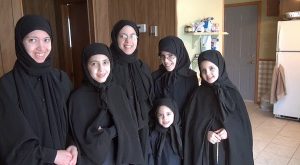 take credit for initiating this practice and for manufacturing these capes but not for the extreme gender separation enforced among Lev Tahor members. [Image at right] Unlike other Haredi groups, Lev Tahor boys are encouraged to do horticultural work, take care of vegetable gardens, and do other chores of maintaining the community grounds.
take credit for initiating this practice and for manufacturing these capes but not for the extreme gender separation enforced among Lev Tahor members. [Image at right] Unlike other Haredi groups, Lev Tahor boys are encouraged to do horticultural work, take care of vegetable gardens, and do other chores of maintaining the community grounds.
In line with most other Haredim, Lev Tahor actively encourages Israelis to refuse conscription and all other collaboration with the Zionist state. Its members spread their doctrine through lectures, brochures, leaflets and media interviews. The fact that the majority of Lev Tahor members are formerly irreligious Israelis constitutes a particular strength of the movement. They can speak the language of ordinary Israelis, are familiar with their everyday realities and find understanding with different groups of Jews, including Sephardim (several Lev Tahor members, including the Rebbe, are of Sephardic ancestry). This makes them more effective in spreading anti-Zionist ideas than, for example, Satmar, which mostly focuses on its own members. This activism constitutes an attractive feature of Lev Tahor for those who join the movement and an additional source of hostility on the part of the Zionists and the Israeli state.
ORGANIZATION/LEADERSHIP
Like all Hasidic groups, Lev Tahor is structured around its leader, the Rebbe, who serves as the model, the spiritual guide and the utmost authority. After the death of Shlomo Helbrans, his son Nahman assumed the leadership of Lev Tahor. It is estimated that the core group consists of a few hundred families with sympathizers around the world. The exact numbers remain unknown.
The group initially developed through recruitment among students of Arakhim, formerly non-observant Jews. A few Orthodox Jews, occasionally from other Hasidic communities, also joined the group. The core of Lev Tahor followed its leader to Canada after he was granted refugee status there. Some of its members are employed as teachers within the community, a few work outside the group; the main source of income likely consists of charitable donations from donors outside of Lev Tahor.
A number of Lev Tahor members emphasized that what had attracted them to the group was the conviction that it stands for truth, i.e. for authentic Judaism (Personal interviews, 2011). Some, including women, said that reading Derekh Hatsalah, well before meeting the Rebbe, made them realize that Lev Tahor was totally devoted to God’s will. Most mentioned the Rebbe’s openness to questions and his willingness to engage both veterans and newcomers in serious study of Judaic sources unlike, they remarked, some other rabbis who engage in brainwashing.
Almost invariably, the interviewees identified classical Judaic (Talmudic) warnings against premature, let alone armed, occupation of the Holy Land as a factor that moved them to anti-Zionism and, subsequently, to Lev Tahor. Zionist ideology and patriotism failed to satisfy those who looked for answers to their existential questions. Some who had served in the Israeli military compared Zionism to an idolatry that demands human sacrifices. A few converts to Judaism who yearned authenticity and strict submission to God also joined the community. The founder’s encyclopedic knowledge of Judaic soures  made him and Lev Tahor in general attractive to inquisitive minds in search of uncompromising consistency. Focusing on asceticism, long prayers and meditation, [Image at right] Lev Tahor draws in spiritually alert Jews rather than those in search of reassuring comfort. Reportedly, every member has to sign an oath of allegiance to the Rebbe before joining the community (“More on” 2017). This practice is rather rare among Hasidic groups.
made him and Lev Tahor in general attractive to inquisitive minds in search of uncompromising consistency. Focusing on asceticism, long prayers and meditation, [Image at right] Lev Tahor draws in spiritually alert Jews rather than those in search of reassuring comfort. Reportedly, every member has to sign an oath of allegiance to the Rebbe before joining the community (“More on” 2017). This practice is rather rare among Hasidic groups.
ISSUES/CHALLENGES
Unlike other leaders of Hasidic communities where leadership is largely dynastic, Helbrans could not claim rabbinic origins and started his group ex nihilo. (Toldoth Aharon is an earlier notable example of a non-dynastic Hasidic group, founded by Rabbi Aharon Roth in Hungary, in the 1920s.) As a consistently uncompromising newcomer to the Hasidic world, Lev Tahor and its leader faced an uphill battle to be accepted as legitimate by other Orthodox streams of Judaism. They succeeded to the extent that Lev Tahor maintains regular contact with several Hasidic groups, such as Satmar, Toldoth Aharon and Tosh.
The main challenge to Lev Tahor comes from its vocal rejection of Zionism and uniquely strict interpretation of Judaic law. This provokes enmity from the state of Israel and its supporters as well as from anti-religious relatives of Lev Tahor members. The fact that Lev Tahor attracts mostly non-observant Israeli Jews makes it appear as a major threat to mainstream Israelis on both ideological and personal levels.
Ideologically, Zionism was supposed to transform the Jews, a confessional community, into a secular national one modeled after European models of a nation. Consequently, Judaism which used to be the pillar of Jewish continuity, would acquire mostly decorative and rhetorical uses for the irreligious founders of the state of Israel. While observant Jews almost unanimously rejected Zionism as a dangerous heresy, secular Zionists used to believe that the religious Jews (or dosim, a derogatory term used by many Israelis) would be affected by the modern atmosphere of the Zionist state, abandon “their old ways” and join its secular Jewish majority. Even though there is some dropout from among the Haredim, their number continues to grow, largely due to their higher fertility rate.
When secular Israeli Jews join the Haredi camp this often causes distress in their families. Many parents and grandparents cannot comprehend how a modern educated son or daughter would embrace antiquated values, strict discipline and secluded lifestyle. They see their children as victims of sects, cults and other sinister entities. This is particularly true of the Ashkenazi descendants of the founders of Israel who shed religious observance and actively fomented a new secular identity. According to the Israeli historian Noah Efron: the secular majority, has a deep fear of the Haredim:
Several friends and colleagues have independently told me about nightmares in which they are captured and held by Haredim and, in some instances, tortured. … More importantly, there is a feeling that one is never safe, that no matter how rationally children are raised, they may ultimately be lured into the Haredi camp.” (Efron 1991:16, 18–19).
Personal fears combine with the ideological antagonism to the Haredim to produce the hostility experienced by Lev Tahor.
This hostility fed into an apparent campaign conducted by Israeli authorities with cooperation of the public and the media. According to his own recorded testimony, an agent of Israeli secret services infiltrated the community. However, within a few months the agent 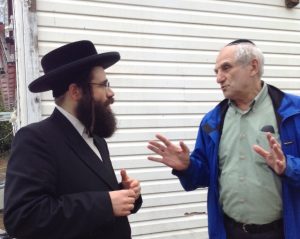 became impressed by Lev Tahor and authentically joined it, eventually becoming a second in command in the community. [Image at right] In view of the attention Israel’s security agencies paid to the community, the campaign likely began when the community was domiciled in Israel in the late 1980s.
became impressed by Lev Tahor and authentically joined it, eventually becoming a second in command in the community. [Image at right] In view of the attention Israel’s security agencies paid to the community, the campaign likely began when the community was domiciled in Israel in the late 1980s.
The campaign was initially focused on Lev Tahor’s opposition to Zionism, but shifted the focus to the treatment of children in the community, which downplayed the political aspect of the campaign. Israeli authorities concluded that denunciations of Lev Tahor’s rejection of the state of Israel was becoming counter-productive as it provided the rationale for considering Lev Tahor members who fled to Canada as political refugees.
Israeli television programmes termed Lev Tahor “a dangerous cult” and alleged it was plotting to murder all non-observant Jews in Israel (a majority of the country’s population). Ominous warnings were sounded: “Lev Tahor sits in Canada but its long claws spread to Israel.”
Several former members of Lev Tahor termed it a cult and accused it of child abuse, physical violence and marriages forced on underage children. However, according to a legal advisor of Israel’s foreign ministry “for seven months the Canadian Community Social Services checked the community and found no evidence of abuse or torture“ (Forte 2014). The fact that the agencies had to make the raids several times reflects an ongoing disagreement as to whether these accusations were actually founded. An experienced medical doctor who inspected over sixty Lev Tahor families in Sainte-Agathe as well as nurses who visited newborn babies and their mothers in their homes found no sign of parental neglect or abuse (Alamenciak 2014; Dumais 2015:16).
Throughout the tribulations of Lev Tahor in Canada, Guatemala and Mexico none of the allegations has been proven in court. However, they are featured as facts in Israeli, Canadian and international media (Kroth 2016). The combined efforts of Israeli authorities, the media, the irreligious parents of Lev Tahor members as well as Zionist circles in Canada and elsewhere resulted in widespread demonization of the community.
One case illustrates the internationalization of the campaign against Lev Tahor. In October 2011, two young Israeli women who, with the consent of their parents, wanted to spend Jewish holidays with Lev Tahor, were apprehended upon arrival in Montreal and prevented from going to Sainte-Agathe. Canadian authorities were acting on behalf of Israel alleging the underage women were going to be married at Lev Tahor. At the request of the women’s distant relatives, Israel had issued a ban on the women’s travel abroad, but was too late to prevent them from leaving the country. Canadian authorities complied with the Israeli move and sent the two women back to Israel against their will. This case embodies the conflict many members of Lev Tahor were thrust into: irreligious grandparents and other relatives would go over the head of the parents who embraced religion in order to place restrictions on the grandchildren (“The Legal Battle” 2011).
Hearings were held in the Israeli parliament in 2013, at which disgruntled parents voiced alarm about their adult children who had joined Lev Tahor. Israeli parliamentarians suggested an Israeli air raid, à la Entebbe, on Sainte-Agathe, Quebec, in order to remove the children from Lev Tahor. Demonstrations were held in front of the Canadian Embassy in Tel-Aviv in 2013 to protest the presence of Lev Tahor in Canada. Israeli authorities, aided by pro-Israel circles in Montreal, put pressure on Canadian and Quebec counterparts (Infokatot), and Quebec child protection agencies repeatedly raided the community, in search of signs of abuse and neglect of children. The authorities’ approach was qualified as “an aggressive child-protection investigation” (Woods May 14, 2014).
The Israeli Vice-Consul had discussed the objectives of the intervention with agents of Quebec child protection agencies. According to a Quebec government report, the allegations against Lev Tahor had come almost exclusively from Israel: Israeli lawyers and police showered Quebec and Canadian authorities with denunciations of “unacceptable educational methods” at Lev Tahor (Dumais 2015: 6, 8, 10, 12, 17).
In May 2013, a married couple with six children, enjoined by the courts not to leave Israel, tried to escape via Jordan in order to join Lev Tahor in Canada. They were stopped and returned to Israel. There had been a restraining order issued against their children, even though the court had not deprived the parents of their parental rights. These legal actions were undertaken by extended family members over the objections of the parents of the children (Charedi 2013).
Concerns about the quality of the education provided by Lev Tahor should be seen in the context of long-standing problems detected in most Haredi schools in Montreal, which fail to fulfill the curricular requirements of the Quebec Ministry of Education. Typically, like other conservative religious communities, Haredim shield their children from external influences and avoid teaching subjects (such as comparative religion, the theory of evolution or sexual education) that are at variance with their understanding of Jewish morality or beliefs. Teenage boys, at Lev Tahor and elsewhere, are often taught 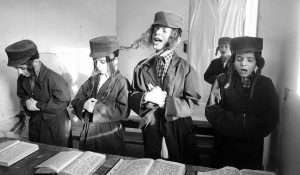 religious subjects to the exclusion of much of the general curriculum. [Image at right] However, it was only in the case of Lev Tahor that child protection agencies demanded to remove children from the parental homes.
religious subjects to the exclusion of much of the general curriculum. [Image at right] However, it was only in the case of Lev Tahor that child protection agencies demanded to remove children from the parental homes.
Fearing that fourteen of their children might be apprehended, Lev Tahor parents with underage children fled Quebec for Chatham, Ontario, which has less stringent controls over the quality of alternative education. Helbrans would later join them in Chatham. At the same time, in November 2013, Canadian authorities issued secret orders preventing Canadian-born Lev Tahor children from leaving Canada, orders that legal experts found “heavy-handed and shocking” (Alamenciak and Woods 2014). An Ontario judge ruled that the court transcripts related to Lev Tahor were to remain secret (Gillis 2016) .
When Ontario authorities threatened to enforce the decisions of Quebec child protection agencies and remove children from their homes, the Hasidim of Lev Tahor fled to Guatemala. (The Jerusalem Post wrongly reported they had fled to Iran, which the Israeli government considered then “an existential threat” (Izso 2013)). Several children were seized in Trinidad and Tobago en route to Guatemala and returned to Canada. Two more, a 17-year-old mother and her baby were apprehended in Calgary. The children thus separated from their parents were placed in foster care. Their request to spend Passover with the community was not accepted by the court. Some of them abstained from food in protest against their forced removal from Lev Tahor and their parents (Third 2014).
Since the United Nations defines “forcibly transferring children of the group to another group” as genocide, it has been argued that the repeated removals of children from Lev Tahor without proven evidence could be qualified as genocide. Indeed, the Ontario judge 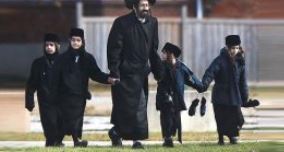 who treated the case of Lev Tahor after they moved from Quebec affirmed that what was at issue was perpetuation of the group through its children (Forte 2014). [Image at right]
who treated the case of Lev Tahor after they moved from Quebec affirmed that what was at issue was perpetuation of the group through its children (Forte 2014). [Image at right]
Sensitivity to this issue is high in Canada, where past removals of aboriginal children from their communities in order to “civilize” them has been officially condemned as genocide. (Spratt 2019) There also remains the dark history of the Doukhbors, a pacifist religious community, which saw its children taken away by provincial authorities in British Columbia and kept for several years separated from their families (Ombudsman 1999). Removing children from the group would be one of the most effective ways to put an end to Lev Tahor. Israeli authorities are also known to have removed babies born to Arab Jews, telling then that the babies had died, and placing them in families of European extraction. This was done in order to reduce the allegedly negative impact of Arab Jewish cultures on the modernization of Israeli society as conceived by the Zionist leaders of the country (Weiss 2002: 61; Halevi Klein 1996:14-19).
Most of Lev Tahor core members, about 150 people, settled in a lakeside town in Guatemala, but were asked to leave after a few months in response to concerns of local indigenous communities about protecting their culture (Woods August 29, 2014). They were later reported living in Guatemala City and in the Mexican state of Chiapas. In September 2016, responding to signals from Israeli authorities, Guatemala police raided several houses of Lev Tahor followers but found nothing suspicious. When the Israeli authorities requested the seizure of all children in the community and offered to transfer them to Israel, the Guatemalan authorities refused their request. Reportedly, Israeli agents had followed Lev Tahor to Guatemala and Mexico, impeding purchases of property there (“More On” 2017). According to a Canadian lawyer who traveled to Guatemala, the chase after Lev Tahor is political in nature (Watch 2016). Prior to Lev Tahor’s flight from Canada an Ontario parliamentarian confirmed that the intervention of the child protection agencies constituted “a political issue,” and that Canadian politicians had been in touch with the local police (Patis 2014).
In early 2017, an Israeli court concluded five years of deliberation ruling that Lev Tahor was “a dangerous cult.” The court’s verdict supported attempts made by irreligious relatives of Lev Tahor Hasidim to remove children from Lev Tahor and bring them to Israel. While only two families figured as defendants, the court’s verdict, a part of which remains secret, stipulated the removal of all children of Lev Tahor from their parents. The court also qualified the Guatemalan town of Oratorio, Department of Santa Rosa, where the community found home, as “the jungle.” Former Israeli Prime Minister Ehud Barak compared Israel to “a villa in the jungle”. Comparing “civilized” Israel with “a villa” and Israel’s Arab neighbors with the “jungle” betrays orientalist attitudes quite common in the Zionist state, which also affect the treatment of Lev Tahor there.
In 2018 and 2019, there were several departures from Lev Tahor. One of them involved a daughter of the founder of Lev Tahor who took her small children to the United States after leaving her husband in Guatemala. These children were later kidnapped in an attempt to bring them back to their father. The kidnappers included several leading members of Lev Tahor. They were arrested and indicted in New York (Oster 2019).
Currently, in spite of persistent efforts by Israeli authorities to destroy Lev Tahor, its members can be found in Britain, Canada, Guatemala, Israel, Mexico, El Salvador and the United States. While precise figures are unavailable, probably the largest community resides in Southwest Guatemala.
** The authors acknowledge the advice earlier drafts of this entry received from Professors Ariel Stravynski and Yaacov Yadgar as well as from Miriam Rabkin.
IMAGES
Image #1: Founding Rebbe of Lev Tahor Shlomo Helbrans.
Image #2: Yakov Rabkin interviewing Shlomo Helbrans.
Image #3: Conversation between two community members.
Image #4: Women and girls of Lev Tahor.
Image #5: A Lev Tahor member in weekday prayer.
Image #6: Yakov Rabkin interviewing Uriel Goldman.
Image #7: Boys of Lev Tahor.
Image #8: A Sabbath walk.
REFERENCES
Alamenciak, Tim. 2014. “Lev Tahor Children speak out for the first time.” Toronto Star, January 16.
Alamenciak, Tim and Allan Woods. 2014. “Secret Lev Tahor Orders prevent Jewish sect’s children from leaving Canada.” Toronto Star April 10.
“Charedi Family Tried to Get to Canada via Jordan.” 2013. Yeshiva World, May 24.
Cohen Yirmiyahu. 2019. Introduction to the Sefer Vayoel Moshe, Brooklyn, NY: True Torah Jews.
Dumais, Jacques. 2015. Etude sur l’intervention du Directeur de la protection de la jeunesse et de ses partenaires auprès de la communauté Lev Tahor et dans des milieux potentiellement sectaires. Accessed from http://www.cdpdj.qc.ca/fr/medias/Pages/Communique.aspx?showItem=678 on 1 September 2019.
Efron, Noah. 1991. “Trembling with Fear: How Secular Israelis See the Ultra-Orthodox, and Why.” Tikkun 6:15-22, 88-90.
Forte, Maximilian. 2014. “Targeting Lev Tahor, from Israel to Canada”. Zero Anthropology. Accessed from https://zeroanthropology.net/2014/04/26/targeting-lev-tahor-from-israel-to-canada/ on 1 September 2019.
Gillis, Wendy. 2014. “Media not allowed to make copies of Lev Tahor transcripts.” Toronto Star, March 19.
Halevi Klein, Yossi, Toronto Star. 1996. “Where Are Our Children?” March 21.
Hart, Alan. 2015. Zionism : the Real Enemy of the Jews. Atlanta, GA: Clarity Press, Three Volumes.
Helbrans, Shlomo, 2011. Ohr Hashem, Sainte-Agathe-des-Monts, Qc : Da’at.
Helbrans, Shlomo, 2001. Derech Hatzolo, Jerusalem, Israel: Da’at
Hisachdus Hayereim and the Office of Derech Hatzolo. 2002. Sainte-Agathe-des-Monts, Qc : Da’at.
Izso, Lauren. 2013. “Ultra-Orthodox anti-Zionist community flees Quebec for Iran.” Jerusalem Post, November 22.
Kroth, Maya. 2016. “A Tale of the Pure Heart.” Foreign Policy, January 25. Accessed from
https://foreignpolicy.com/2016/01/25/a-tale-of-the-pure-at-heart-guatemala-israel-lev-tahor-judaism-religion/ on 1 September 2019.
“The Legal Battle Surrounding Lev Tahor Sect – AKA ‘Jewish Taliban Women’.” 2011. Yeshiva World, October 5..
“More on the Death and Levaya of ‘Lev Tahor’ Cult Leader Shlomo Helbrans That Drowned In Mexico.” 2017. Yeshiva World, June 11,
Ombudsman Province of British Columbia. 1999. Public Report No. 38: Righting the Wrong: The confinement of the Sons of Freedom Doukhobor Children.
Oster, Marcy. 2019. “Indicted for Kidnapping Attempt.” Jerusalem Post, July 31.
Patis, Ashton, 2014. “Lev Tahor a Political Issue.” Blackburnnews.com, March 31. Accessed from https://blackburnnews.com/chatham/chatham-news/2014/03/31/lev-tahor-a-political-issue/ on 1 September 2019.
Personal Interviews. 2011. A series of interviews were conducted by Yakov Rabkin and Estela Sassón in May 2011 in Sainte-Agathe.
Rabkin, Yakov. 2006. A Threat from Within: A Century of Jewish Opposition to Zionism, London: Zedbooks.
Ravitzky, Aviezer. 1996. Messianism, Zionism, and Jewish Religious Radicalism. Chicago: University of Chicago Press.
Spratt, Michael. 2019. “Canada’s treatment of Indigenous peoples fits the definition of ‘genocide’.” Canadian Lawyer, June 10.
“Third Child In Lev Tahor Cult Who Is Hunger-Striking Has Been Hospitalized.” 2014. Yeshiva World, March 11.
Weiss, Meira. 2002. The Chosen Body: The Politics of the Body in Israeli Society. Stanford, CA: Stanford University Press.
“Watch: Lev Tahor’s Lawyer in Defense of the Cult.” 2016. Yeshiva World, September 21.
Woods, Allan. May 14, 2014. “Quebec human rights commission looking at what went wrong in Lev Tahor case.” Toronto Star, May 14.
Woods, Allan. August 29, 2014. “Jewish Group Lev Tahor expelled from Guatemala Sanctuary.” Toronto Star, August 29
Publication Date:
21 September 2019
